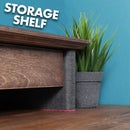Introduction: DIY Philips Hue Panel Light
I recently bought some Philips Hue lights for my bedroom. They're great! I can control them with my voice using Alexa and also control them via my phone too. I tried to find a colour changing panel light but as you may be aware, Philips Hue don't sell one. So I had a go at making my own. Didn't go totally to plan but I'm still pleased with the results.
I have a video of the project here:
Materials Used:
Tools Used:
- Drill with 6mm bit
- Countersink
Optional:
- Tape
- Scrap Wood
Step 1: Drill & Countersink
The first thing I needed to do was align both the Mirrored and Opal pieces of Perspex. Some strips of painters tape helps to hold them together.
Then its just a case drilling holes through both layers of perspex. Putting the perspex on top of some scrap wood while drilling will prevent tear out and make for a cleaner hole.
I drilled a hole in each corner and in the middle of the longer edge on both sides with a 6mm drill bit. Giving me 6 holes in total.
The heads of the machine screws will be protruding from the opal perspex so using a countersink in the drill enables them to sit flush.
Step 2: Add the Light Strip
I chose to use mirrored perspex for the back of the panel because the mirrored surface should help reflect the light forward. In theory anyway.
Adding the light strip couldn't be simpler. It has an adhesive backing to it so its just a case of peeling off the paper and sticking it down. I laid the lights out in straight lines. Because they don't bend very well the ends have a twisted curve but it doesn't effect the light output really.
I made sure the power input was off to the one side. This will give me easy access later.
Step 3: Put It All Together
Now its just a case of putting it all together. The opal perspex should work well at diffusing the light so that's what will be used for the front of the panel. I pushed the 30mm M6 Machine screws through the holes I drilled earlier so they are all sitting upright.
Then I added 15 washers to each machine screw to act as spacers. I wanted to keep it as simple as possible. Washers are cheap and do the job. Plus you can add more or less to adjust the spacing.
With the washers in place I could add the mirrored perspex with the lights attached. Of course it goes face down so the light will shine through the opal perspex. The holes should all line up and sit on the machines screws.
It all get held in place with a wing nut on each machine screw.
That's the panel done. Now to add the power and test it out! I was really happy with how it turned out. I did say in my video how I wanted it on my ceiling. You'll see in the next step how that turned out...
Step 4: Fail! Kind Of...
I already had a LED panel light on my ceiling so I simply swapped it out for the Philips Hue one. The LED power driver matched the output of the Philips power adaptor so I thought it would be as simple as plugging it in and powering it on..... I was wrong. All I got a was a brief flash of light and then nothing. I did contact Philips to ask about using other power supplies with the Hue Strip lights. They said the lights only work with the Philips power adaptor. I'm guessing there is some communication between the power adaptor and the lights them selves.
Oh well, another lesson learned. The panel light will still be great for my video production and photography. As you can see in the images it adds a lot of interest to smaller items being photographed. It will also be great for adding extra light and interest to video scenes.
The small light in the photograph was a gift from my friend Claire. Check out her social media here:
YouTube - https://youtu.be/hbM6_EVX_nI
Facebook - https://www.facebook.com/makingitoutofthewoods/
Instagram - https://www.instagram.com/making_it_out_of_the_woods

Participated in the
Epilog Challenge 9

Participated in the
Remote Control Contest 2017










![Tim's Mechanical Spider Leg [LU9685-20CU]](https://content.instructables.com/FFB/5R4I/LVKZ6G6R/FFB5R4ILVKZ6G6R.png?auto=webp&crop=1.2%3A1&frame=1&width=306)


